how to grow lettuce at home quick and easy guide

Lettuce is one of the easiest vegetables to grow indoors or outdoors, perfect for beginner gardeners. Hone your gardening expertise by growing lettuce and improve your hydroponic skills.
Please check the following video for growing mint plant in home easily:
Introduction
Lettuce commonly known as Lactuca sativa is an annual leaf vegetable that belongs to the aster family. It is one of the most popular and everyone’s favorite garden vegetables throughout the world. Most Lettuce varieties are eaten fresh and raw and can also be served as green salads. North America and Europe commercialized the growth of Lettuce for the first time. Nowadays, It has been transported all over the world.
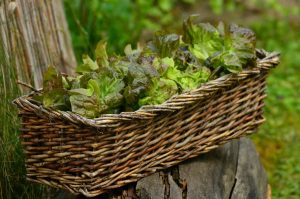
Climatic Condition
Lettuce is a cool-season crop that grows to its full potential in the spring and fall seasons. Low temperature is highly preferred because it can prevent these plants from flowering quickly. However, in warmer, temperate seasons requires an adequate amount of water or irrigation. Temperature is preferred around 55 to 65 degrees Fahrenheit. Spring season and late summer can be considered as the best season to grow Lettuce. Seedlings of Lettuce can barely tolerate light frost.
Types of Lettuce
- Iceberg
- Cosberg
- Buttercrunch
- Red/Green Oak
- Red/Green coral
- Endive, etc
Specialties
- Lettuce plants can grow up to a height of 15-30 cm.
- These plants can have tap roots or fibrous root systems.
- Leaf colors of lettuce vary from green and deep red to purple and sometimes blue-teal.
- They are found in a wide range of shapes and textures.
- Generally, lettuce survives 65-130 days from planting to harvesting.
Variety of lettuce to grow
Butterhead, Romaine and Leaf lettuce are the most common varieties of lettuce to grow. The planting techniques for each type don’t differ at all, so you can pick up any kind of lettuce and grow any way you like.
Planting Techniques
All varieties of lettuce are flexible and can be grown using any method. The most common ways are as follows:
- Directly sow the seeds in the soil
- Indoor container method
- Hydroponics
Growing medium
To grow lettuce, the soil needs to be well-drained. Natural compost such as humus soil is great for planting lettuce as it contains fallen leaves, dead plants, and animal matter decayed over time. Mixing the soil with perlite, coir, peat moss, etc. always provides the perfect balance for the healthy growth of the lettuces.
Steps to grow lettuce indoors by using a container
Take a shallow depth tray and fill it with growing medium as mentioned above


Get some lettuce seeds and spread a couple of them in each slot.

Cover the container with the growing medium and pour some water on top of it.
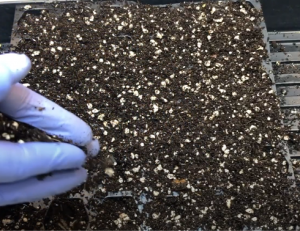

Cover the container with light plastic wrap, so the moisture inside it won’t escape.

After 4 days, you can see the seeds sprouting very well. Note: Watering is not required for a few days.

Lettuces need light as well, so you can put them under growth lights or natural light. After 10 days, you can see the lettuce plants flourishing and tilting towards the growing light. Spray some water as well.

After 21 days, you can see the lettuce growing taller, spread some more soil to strengthen the lettuce roots, and spray some water.

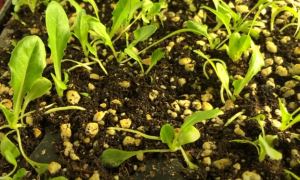
If you witness the roots getting longer as well, that means the lettuces need a lot of water, so don’t be afraid of the consequences of overwatering the plants as there are none.


After 35 days, the plants have grown vigorously. This also means that these lettuce plants are now ready to be transplanted.
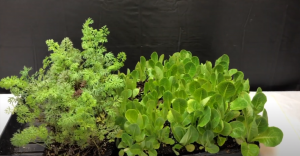
Now for transplanting, get any ordinary aluminum tray and make some holes on the bottom for drainage. Pour the growing medium almost full into the container.


You can transplant each to their independent container or all of them in a single container. Sprinkle some growing medium on top after transplantation is complete.


Don’t forget to water every day, lettuces need tons of water to grow healthy.

After transplanting, place them again in the growing light. After 45 days you can see the plants have grown taller, which is a good sign that they are growing properly.
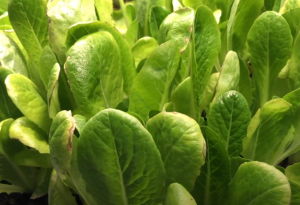

At this stage, they are ready to be harvested. You can continue to grow it taller or prune external leaves that have grown taller so you can make your favorite salad.

Don’t forget to get rid of dying or decaying lettuce plants, they can affect other healthy plants as well.


Salad Recipe
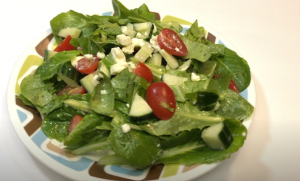
Grab a few romaine lettuce leaves and clean the leaves thoroughly with water.

Slice a cucumber into small pieces and mix it with the salad leaves.

Slice and dice a few cherry tomatoes.

Add some cheese and mix it with olive oil.
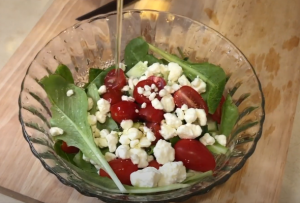
Health Benefits
- It enhances and promotes the metabolism of the body.
- Maintain the hydration level of the body.
- Great source of Antioxidants.
- Reduces various heart problems.
- Maintain sugar level and lowers diabetes.
- It prevents the growth of cancer.
- Reduces fatigue and stress.
- Used as food to counteract the chances of Alzheimer’s disease.
Nutritional Facts (1 cup shredded, 36 g of Lettuce plant contains)
Source: https://www.healthbenefitstimes.com/lettuce/
Calories: 5 KCal
Vitamin K: 37.92%
Vitamin A: 19.00%
Manganese: 3.91%
Iron: 3.88%
Vitamin C: 3.67%
Vitamin B2 (Riboflavin): 0.029 mg (2.23%)
Vitamin B1 (Thiamin): 0.025 mg (2.08%)
Isoleucine: 0.03 g (1.79%)
Interesting Fun Facts
- Egyptians used to produce oil from lettuce seeds.
- It is said that Lettuce was served on the tables of the Persian kings of the 6th century BC.
- Ethylene can cause lettuce to ripen very fast.
- Lettuce should not be stored or placed near apples, bananas.
- The United States produces 70% of the total world’s lettuce plants.
- Christopher Columbus who is known for discovering America was the person who actually introduced lettuce to America.





excellent info on moringa plants, where can I purchase seeds to plant it?
The best place is amazon at your location. Try checking some agro stores around you. Let us know for more questions.
A very interesting article. I thought they were part of pilea peperomioids. These nasturtium grow like weeds where I live in southern part of South Africa. The only problems are snails. They are hardy and face drought conditions well. We don’t get frost. I love them xx
Thank you for your comment. I really appreciate it. Please be with us and help us share with your friends and family.
You are so right about choosing well drained soil for planting the grapes. It worked great when we tried.
Thank you for your comment. We appreciate it.